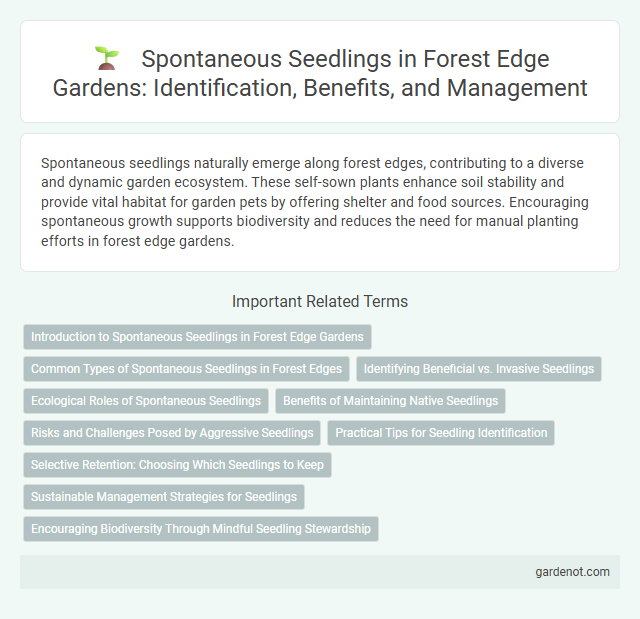Spontaneous seedlings naturally emerge along forest edges, contributing to a diverse and dynamic garden ecosystem. These self-sown plants enhance soil stability and provide vital habitat for garden pets by offering shelter and food sources. Encouraging spontaneous growth supports biodiversity and reduces the need for manual planting efforts in forest edge gardens.
Introduction to Spontaneous Seedlings in Forest Edge Gardens
Spontaneous seedlings naturally emerge in forest edge gardens as a result of seed dispersal by wind, animals, or water, promoting biodiversity without human intervention. These seedlings contribute to the dynamic ecological balance by introducing native and sometimes unique plant species that adapt to the specific microclimate of forest edges. Recognizing and nurturing spontaneous seedlings can enhance soil health, support wildlife habitats, and increase the resilience of the garden ecosystem.
Common Types of Spontaneous Seedlings in Forest Edges
Spontaneous seedlings commonly found in forest edge gardens include native species like maple (Acer spp.), oak (Quercus spp.), and sumac (Rhus spp.), which naturally regenerate from nearby mature trees. These seedlings contribute to biodiversity by establishing diverse plant layers that support wildlife habitats and soil stabilization. Monitoring the growth patterns of species like cherry (Prunus spp.) and dogwood (Cornus spp.) helps manage forest edge dynamics and promotes ecological balance.
Identifying Beneficial vs. Invasive Seedlings
Spontaneous seedlings at the forest edge garden often include both beneficial native species and invasive plants that threaten ecosystem balance. Identifying seedlings involves examining leaf shape, growth patterns, and root structure to distinguish valuable biodiversity enhancers from aggressive invaders. Early removal of invasive seedlings ensures preservation of native flora and supports healthy forest edge regeneration.
Ecological Roles of Spontaneous Seedlings
Spontaneous seedlings at the forest edge garden play a crucial role in enhancing biodiversity by naturally regenerating native plant species. These seedlings contribute to soil stabilization, prevent erosion, and create microhabitats for insects and small wildlife. Their presence supports ecological succession and helps maintain the resilience of the forest edge ecosystem.
Benefits of Maintaining Native Seedlings
Maintaining native spontaneous seedlings at the forest edge garden promotes biodiversity by supporting local wildlife and enhancing ecosystem resilience. These seedlings contribute to soil health through natural nutrient cycling and help preserve the genetic diversity of indigenous plant species. Encouraging native seedling growth reduces the need for artificial inputs, fostering a sustainable and self-regulating garden environment.
Risks and Challenges Posed by Aggressive Seedlings
Spontaneous seedlings in forest edge gardens often pose significant risks by outcompeting native plants for resources such as sunlight, water, and nutrients, leading to reduced biodiversity. Aggressive seedlings can rapidly dominate the area, disrupting the delicate ecological balance and hindering the growth of desirable species. Managing these invasive seedlings requires careful monitoring and timely intervention to prevent long-term damage to the garden's health and sustainability.
Practical Tips for Seedling Identification
Spontaneous seedlings in forest edge gardens can be identified by closely observing leaf shape, stem texture, and growth patterns compared to nearby mature plants. Practical tips include marking new seedlings with biodegradable tags and documenting their appearance over time to track development. Using a hand lens can aid in distinguishing fine hairs, pigmentation, and vein structures crucial for accurate identification.
Selective Retention: Choosing Which Seedlings to Keep
Selective retention in forest edge gardens involves carefully choosing spontaneous seedlings that exhibit strong growth, adaptability, and compatibility with the existing ecosystem. Prioritizing native species enhances biodiversity and supports local wildlife habitats, while removing weaker or invasive seedlings prevents resource competition. This deliberate selection promotes a sustainable and resilient garden that thrives naturally over time.
Sustainable Management Strategies for Seedlings
Spontaneous seedlings at the forest edge garden offer a natural regeneration method, reducing the need for artificial planting and minimizing soil disturbance. Sustainable management strategies prioritize selective thinning and mulching to enhance seedling survival while maintaining biodiversity and soil health. Monitoring growth patterns and integrating native species support ecosystem resilience and long-term forest sustainability.
Encouraging Biodiversity Through Mindful Seedling Stewardship
Spontaneous seedlings at the forest edge garden play a crucial role in promoting biodiversity by naturally introducing diverse plant species into the ecosystem. Mindful seedling stewardship involves selectively nurturing these seedlings to support native flora and enhance habitat complexity, which benefits pollinators and wildlife. This approach fosters a resilient and balanced forest edge environment by maintaining genetic diversity and ecological interactions.
Spontaneous seedling Infographic

 gardenot.com
gardenot.com